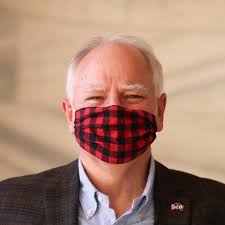Tim Walz Under Fire for Nursing Home COVID-19 Policies: A Closer Look
Minnesota Governor Tim Walz, who is now Vice President Kamala Harris’ running mate, has come under intense scrutiny for his administration’s handling of COVID-19 in nursing homes during the height of the pandemic. Critics have pointed to his decision to allow hospitals to discharge COVID-positive patients back into nursing homes, a policy that contributed to a devastating toll among the state’s elderly population.
A Controversial Decision
In May 2020, as Minnesota reported one of the highest percentages of COVID-19 deaths in long-term care facilities nationwide, Governor Walz defended his decision, stating, “This was not a mistake… This was what everyone was doing.” His administration’s policy was similar to those implemented by other states, including New York under Governor Andrew Cuomo, but Minnesota saw particularly severe outcomes. According to the Foundation for Research on Equal Opportunity, over 80% of the state’s COVID-19 deaths occurred in nursing homes—the highest rate in the nation.
Despite warnings from the Centers for Disease Control and Prevention (CDC) that nursing home residents were at high risk for severe illness and death from COVID-19, the Walz administration continued to support the discharge of infected patients back into these facilities. This approach has been widely criticized for exacerbating the spread of the virus among the most vulnerable populations.
Families Left in the Dark
Many families of nursing home residents have expressed anger and sorrow over how the situation was handled. During the pandemic, some were not informed that their loved ones had contracted the virus, and tragically, many were never able to say their goodbyes. The policy that allowed COVID-positive patients to return to nursing homes has since been removed from the Minnesota government’s public website, but its impact continues to resonate.
Broader Criticism
Governor Walz’s handling of the pandemic has drawn criticism on multiple fronts. In addition to the nursing home policy, he has been accused of implementing overly harsh COVID-19 restrictions, including strict lockdown mandates and harsh penalties for non-compliance. His approach during the pandemic, which some view as heavy-handed, has raised questions about his leadership in times of crisis.
House Majority Whip Tom Emmer (R-Minn.) voiced strong opposition, stating, “From overseeing the largest COVID-19 fraud scheme in the country to forcing hospitalized COVID patients back into nursing home facilities, Tim Walz proved during the pandemic he does not have the competency to lead in times of crisis.”
Looking Ahead
As Tim Walz moves into the national spotlight as a vice-presidential candidate, his record during the COVID-19 pandemic is likely to remain a point of contention. The debate over how best to protect vulnerable populations during a health crisis is ongoing, but the experience in Minnesota has highlighted the challenges and consequences of such decisions.
The situation serves as a stark reminder of the critical importance of careful and compassionate policymaking, especially when it comes to the care of our most vulnerable citizens. As the nation reflects on the lessons learned from the pandemic, the focus must remain on ensuring that nursing homes are safe, well-equipped, and properly managed to protect residents from future health threats.


